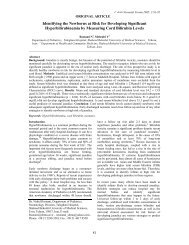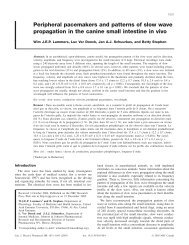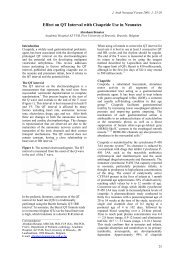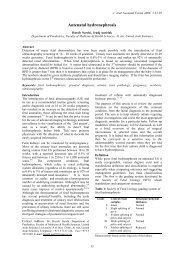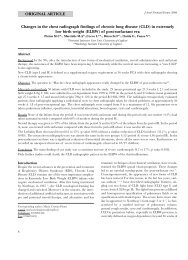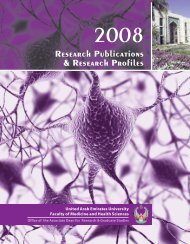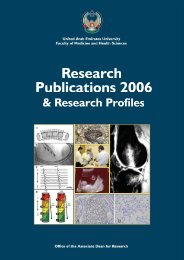Research Publications - College of Medicine and Health Science
Research Publications - College of Medicine and Health Science
Research Publications - College of Medicine and Health Science
You also want an ePaper? Increase the reach of your titles
YUMPU automatically turns print PDFs into web optimized ePapers that Google loves.
Diabetic neuropathy <strong>and</strong> retinopathy<br />
Changes in gene expression in the diabetic eye,<br />
in sympathetic <strong>and</strong> dorsal root ganglia, corpus<br />
cavernosum <strong>and</strong> vascular tissues were investigated<br />
by low density expression array in studies<br />
funded by the Emirates Foundation <strong>and</strong> the<br />
FMHS by Pr<strong>of</strong>essors Adrian <strong>and</strong> Morrison. Several<br />
interesting early changes in gene expression<br />
were seen, particularly in the retinas <strong>of</strong> diabetic<br />
animals. Ongoing studies include confirmation<br />
<strong>of</strong> the expression changes using fast real-time<br />
RT-PCR <strong>and</strong> immunocytochemistry for the<br />
protein products <strong>of</strong> these genes in collaboration<br />
with Dr. Eric Mensah-Brown in the Department<br />
<strong>of</strong> Anatomy. Marked changes in gene expression<br />
have been documented. For example, in the<br />
pelvic ganglia from diabetic animals the expression<br />
<strong>of</strong> vasoactive intestinal polypeptide (VIP)<br />
<strong>and</strong> neuronal nitric oxide synthase (nNOS) are<br />
dramatically reduced in diabetic animals, while<br />
expression <strong>of</strong> another transmitter, Cholecystokinin<br />
(CCK) is dramatically increased. Since VIP<br />
<strong>and</strong> nNOS play a role in penile erection <strong>and</strong> in<br />
control <strong>of</strong> bladder function, these changes are<br />
likely to explain the erectile dysfunction <strong>and</strong> for<br />
urinary retention that are seen in diabetics.<br />
Early changes in expression <strong>of</strong> several genes, including<br />
calpain 3, <strong>and</strong> several crystallins, in the<br />
retina have been seen in three different models<br />
<strong>of</strong> diabetes in the rat. Changes in expression<br />
<strong>of</strong> these genes are likely to be involved in the<br />
pathophysiology <strong>of</strong> cataracts, diabetic retinopathy<br />
<strong>and</strong> glaucoma.<br />
������������������������������������������<br />
hormones in diabetes <strong>and</strong> obesity<br />
Enteroendocrine L-cells produce glucagon gene<br />
products (GLP-1 <strong>and</strong> oxyntomodulin) as well<br />
as PYY. All are satiety factors. GLP 1 is also an<br />
incretin. The number <strong>of</strong> L-cells <strong>and</strong> hormonal<br />
contents increases distally through the gut<br />
with highest concentrations in the rectum. We<br />
have previously shown that intracolonic infusion<br />
<strong>of</strong> bile salts in humans causes secretion <strong>of</strong><br />
L-cell hormones, triggered via TGR5 membrane<br />
receptors. Together with colleagues in the<br />
Department <strong>of</strong> Internal <strong>Medicine</strong>, Pr<strong>of</strong>. Adrian<br />
has been investigating release <strong>of</strong> these lower GI<br />
hormones in obese patients with type 2 diabetes<br />
mellitus. Using a simple <strong>and</strong> well-tolerated<br />
agent, this group has shown substantial increases<br />
in circulating concentrations <strong>of</strong> GLP-1,<br />
PYY <strong>and</strong> insulin. The release <strong>of</strong> the lower GI<br />
hormones resulted in a fall in circulating glucose<br />
levels <strong>and</strong> a marked reduction in spontaneous<br />
caloric intake <strong>of</strong> a subsequent meal. This mechanism<br />
is likely to be valuable in the treatment<br />
<strong>of</strong> type 2 diabetes <strong>and</strong> obesity. Investigations<br />
focused on the improvement <strong>of</strong> diabetic status<br />
<strong>and</strong> reduction in body weight with chronic<br />
administration <strong>of</strong> bile salts are planned.<br />
Relative expression <strong>of</strong> mRNA for VIP, neuronal NOS (NOS1), NOS2, somatostatin, <strong>and</strong> CCK in pelvic ganglia from control rats <strong>and</strong><br />
diabetic rats 12 weeks after treatment with streptozotocin. Real-time RT-PCR confirmation <strong>of</strong> low density gene expression array<br />
data, n=8 in each group.<br />
Department <strong>of</strong> Physiology<br />
87




